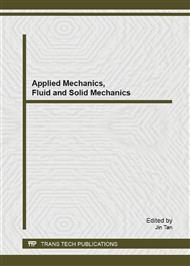[1]
ANSYS® Academic Research, Release 14. 0. Southpointe, USA: ANSYS, Inc., (2011).
Google Scholar
[2]
CSN EN 1991-1-4: 2007 Eurocode 1: Actions on structures – Part 1-4: General actions – Wind loads. Prague: UNM, (2007).
DOI: 10.1680/dgte1.31524
Google Scholar
[3]
CSN 73 1901: 1999 Designing of roofs – Basic provisions. Prague: UNM, (2013).
Google Scholar
[4]
FERZIGER, Joel H. Computational methods for fluid dynamics. 3rd, rev. ed. Berlin: Springer, 2002, 423 s. ISBN 35-404-2074-6.
Google Scholar
[5]
CHUNG, T. Computational fluid dynamics. 2nd ed. Cambridge: Cambridge University Press, 2010, xxii, 1034 s. ISBN 978-0-521-76969-3.
Google Scholar
[6]
WENDT, John F a John David ANDERSON. Computational fluid dynamics: an introduction. 3rd ed. London: Springer, 2008, xii, 332 p. ISBN 36-420-9873-8.
Google Scholar
[7]
MILNE-THOMSON, L. Theoretical aerodynamics. 4th ed., rev. and enl. New York: Dover Publications, 1973c1958, xviii, 430 p. ISBN 04-866-1980-X.
Google Scholar
[8]
Surana, K. S., Allu, S., Tenpas, P. W. and Reddy, J. N. (2007), k-version of finite element method in gas dynamics: higher-order global differentiability numerical solutions. Int. J. Numer. Meth. Engng, 69: 1109–1157. doi: 10. 1002/nme. 1801.
DOI: 10.1002/nme.1801
Google Scholar
[9]
WILCOX, David C. Turbulence modeling for CFD. 3rd ed. La Cañada: DCW Industries, 2006, 522 s. ISBN 19-287-2908-8.
Google Scholar
[10]
POPE, S. Turbulent flows. Cambridge: Cambridge University Press, 2000, xxxiv, 771 p. ISBN 978-0-521-59886-6.
DOI: 10.1080/03091920410001700805
Google Scholar
[11]
ANDERSON, John D. Computational Fluid Dynamics: The Basics with Applications. New York: McGraw-Hill Book Company, 1995, 547 s. ISBN 00-700-1685-2.
Google Scholar
[12]
PATANKAR, Suhas V. Numerical heat transfer and fluid flow. Bristol, PA: Taylor, c1980, xiii, 197 s. Series in computational and physical processes mechanics and thermal sciences. ISBN 08-911-6522-3.
Google Scholar
[13]
BARTOS, Tomáš, PENCIK, Jan. Parametric study of flow velocity in ventilated double-skin roof on the inlet velocity. In 20th SVSFEM ANSYS Users' Group Meeting and Conference 2012. Prerov, Czech Republic: SVS FEM s. r. o., 2012. s. 1-6. ISBN: 978-80-260-2722-5.
Google Scholar


